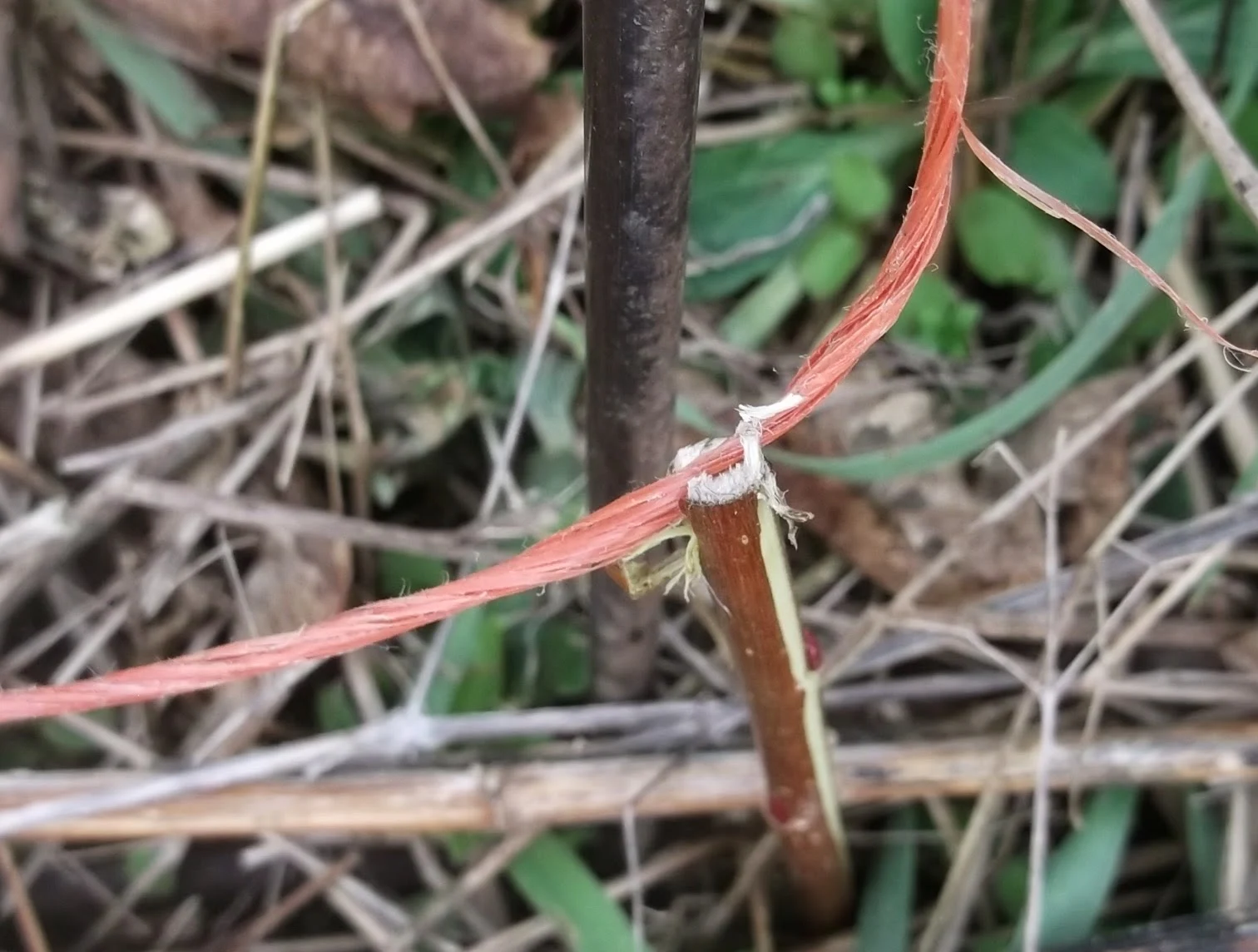 |
| Almost done. |
 |
| Close-up of left side. A flap of bark (and sliver of wood) made by a downward cut with a sharp pocket knife. |
 |
| Close-up of right side. A stick of pencil diameter (willow, in this case) pushed into the ground. A split is made fairly deeply and the loop pushed in just enough to catch. |
 |
| A third option for supporting the loop. A twig that was cut to leave a 1/2" (12mm) stub that the loop is draped over. |
Some key points:
- Many kinds of wire and cordage can be made to work.
- Short leads (length between anchor and start of loop) are stiffer and tighten up more quickly than long leads.
- A total length of 18"-to-20" ( 500mm) is a good starting point for length.
- Run the loop like a "6" rather than an upside down "9". There will be less sawing motion of the loop against the animal as it tightens
- Regardless of wire/cordage, make the loop at the end of the lasso generous....diameter of your pinky is not too big. That reduces friction of run-down.
- Many jurisdictions prohibit trapping or snaring of "game" animals. In Michigan, that includes native species of rabbits. But in rather convoluted logic, feral European rabbits (Oryctolagus cuniculus) are considered an invasive alien species (like starlings) and may be taken with a snare. You are responsible for compliance with your local laws!
- In the absence of "entanglement", the captured animal will usually be quietly waiting, alive, for your return. Be prepared to release or bring-to-bag.
Wire, cordage, etc.
One of the appeals of gaining expertise in snaring is the prepping/survivalist/live-off-the-land angle.
Any technique that requires exotic materials is foolishness as it merely displaces where the user is dependent upon a (potentially fragile) supply chain.
The wire/cordage must be strong enough to hold the lunges of the varmint. It must resist or be tolerant of kinking. It is advantageous if it is not super visible. It must be limp enough so the animal will tighten the loop without becoming alarmed. It is desirable for the material to take a set or otherwise not allow the loop to loosen.
Some jurisdictions allow snaring and they often specify what kinds of material you can use. For example, Manitoba, Canada allows the snaring of rabbits but mandates 22-to-24 gauge brass-or-copper wire. Problem solved.
Another material known to work is multi-strand picture hanging wire. However, 22 gauge florist or paddle wire is too vulnerable to kinking to reliably hold a capture. 22 gauge steel wire that was not dead-soft might work but I have not data. Snaring is one of those activities where you learn by doing and by making adjustments.
22-to-24 gauge brass and copper wire are rarely "found materials" in my neck of the woods. So I wanted to figure out how to make "native" materials work.
 |
| Oh, look! A herd of hay bales! |
 |
| A closer view |
 |
| An even closer view. At twelve wraps to the bale and twelve feet to the wrap, that is enough cordage for about 90 snares....on each bale. And the farmers throw it away. |
The material is plenty strong, it has a knot breaking strength of 130 pounds. It is somewhat vulnerable to chewing. Its primary disadvantage is limpness. It requires much support to hold it up in the proper position. That is why I took the trouble to show three different techniques for supporting the loop.
If your garden is besieged by Varminticus bugsbunnicus and you have no other means of control, and don't want to go scrounging, nor do you want to buy a lifetime's supply of cord, the synthetic cord given away at big-box, building supply stores will probably work. This white, poly cord was given to me by Menards. I like the baling twine better because it is UV resistant but I am sure this cord would work in a pinch.
Finding runs
Snaring is a numbers game. Not every trail gets used every night. The key is to identify good places to set up snares and to set up more than one.
One will learn volumes by walking around after a light snow.
 |
| Hey Grandpa. He went thattaway. |
A good dog will tell you much if you slow down and let him poke around. These dogs are telling me something by where they poke their head through the fence. They are not sniffing for truffles.
One can bias traffic by opening up a fence loop so it is more generous in size. One can also jam sticks in other openings to make them less attractive to traffic. Yes, I know that a varmint could squeeze through, but they are lazy.
Good hunting.



Just showed this post to my 11 year old son, who has quite the interest in this sort of thing. As a matter of fact, he will be getting a book on trapping and snaring for Christmas, along with some snares. His main goal is to snare or trap a beaver, but I think he will start with some smaller game. He and I both enjoyed this post, and you've given him lots of ideas.
ReplyDeleteCool!
DeleteHave you ever seen a copy of The American Boy's Handy Book? I think he would enjoy it. http://www.amazon.com/American-Boys-Handy-Book-Centennial/dp/0879234490/ref=sr_1_1?ie=UTF8&qid=1418784370&sr=8-1&keywords=american+handy+boy+handbook
The boys received a copy of that book for Christmas last year. They did enjoy it! When the little one gets his snares and book on trapping, the older one is getting a book about tracking. We'll see what they can learn :-)
ReplyDelete